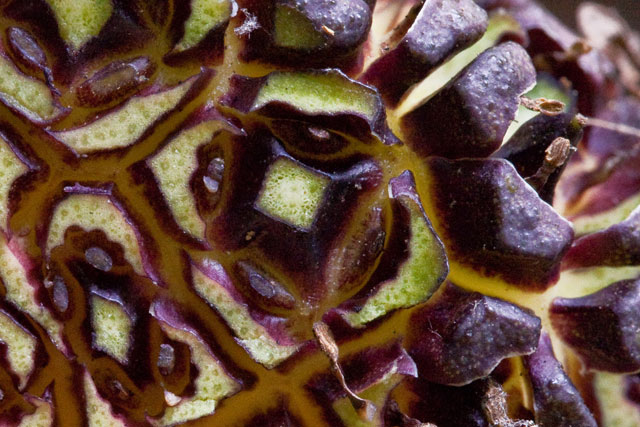 |
 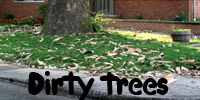 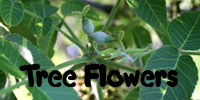 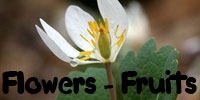 |
Welcome
to bobklips.com, the website of Bob Klips, a plant enthusiast living in
Columbus, Ohio. Ring around the phloem! Larvae call it home! (If only we could slow 'em!) Ashes, ashes, all fall DOWN! (Southern Michigan EAB trip, June 15-17, 2009) The beetle Agrilus planipennis is so boring that many people are interested in it! This week I had the pleasure of doing field work with some of them --a group of scientists from the USDA Forest Service and Ohio State University who are monitoring the ecological impact of the Emerald Ash Borer. EAB is an Asian insect that is killing our ash trees. The beetle's larvae feed on the inner bark, and are so numerous that the extensive galleries they produce girdle the tree, completely blocking the transport of water and nutrients. The beetles were first discovered in southeastern Michigan in 2002, so the locations we visited are near the epicenter of this devastating infestation. 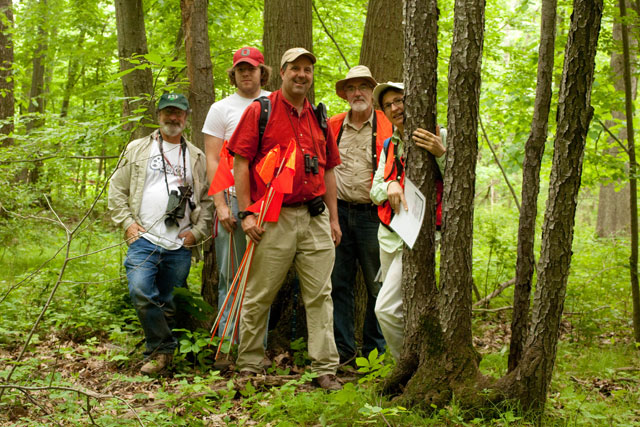 OSU and USDA Forest Service EAB researchers. July 16, 2009. Southeastern Michigan. One of the sites was a black ash swamp. Black ash, EAB notwithstanding, is an uncommon tree that is always a thrill to see. It is ecologically unique, one of only a few trees that can grow in persistently saturated soil. Also, the wood is softer than other ashes, and logs can be treated in a manner that causes the wood to separate between the growth rings. Following that, thin strips can be produced by cutting the logs lengthwise. These strips are used to make the distinctive Adirondack style pack baskets. Black ash can be recognized by its leaves having more leaflets than do other ashes, at first glance looking somewhat walnut-like, but with oppositely arranged leaves. Ashes (and also boxelder, a.k.a. "ash-leaved" maple) are our only trees with opposite, pinnately compound leaves. Also, black ash leaflets are stalkless (sessile), while the leaflets of other ashes have stalks (petiolules). 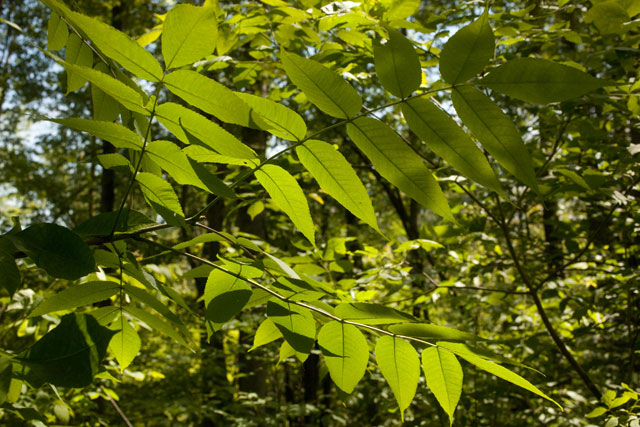 Black ash sapling. June 15, 2009. Southeastern Michigan. The black ash swamp is
home to
several wetland plants. Being in the understory, how might
they respond to the extra sunlight
in the newly-formed gaps occasioned by the loss of the ash
trees? Royal fern (Osmunda regalis, family
Osmundaceae) is a robust
fern, the leaves of which are thrice-compound, but they are so large
that the sub-leaflets look almost like separate individual leaves.
Unlike many ferns, which produce their spores underneath otherwise
normal-appearing (leafy?) leaves, royal fern sporangia are instead
borne at the tips of each huge leaf, on portions wholly
modified for the production of spores. These fertile portions of the
fronds are the gnarly-looking tops
of the plants in the photo below.
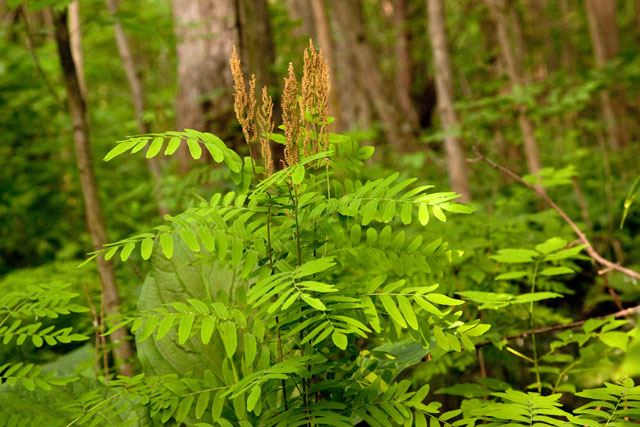 Royal fern in black ash swamp. June 15, 2009. Southeastern Michigan. Lake sedge (Carex lacustris, family Cyperaceae) is an especially robust sedge, sometimes forming extensive stands. 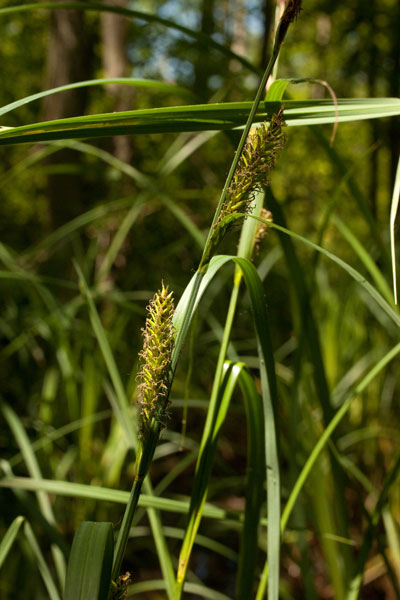 Lake sedge in black ash swamp. June 15, 2009. Southeastern Michigan. Having only heard about
the emerald ash
borer, but not having seen (or at least noticed) its effects firsthand,
it sure was a shock to see that it's true
...all the ash
trees up there are dead, moribund, or temporarily too
small to attract the insect's attention. The researchers'
assay procedure is to record all of the tree species present within 18
meter square
quadrats and to specify "canopy class" values from 1-5 that denote the
degree
to which the various trees were fully leafy (canopy class 1) or
completely barren (canopy class 5). Essentially all the ashes were
canopy class 5! (That's an exclamation point after the "5," not a
"factorial" sign. There was no canopy class 120.) Dead, dead, dead.
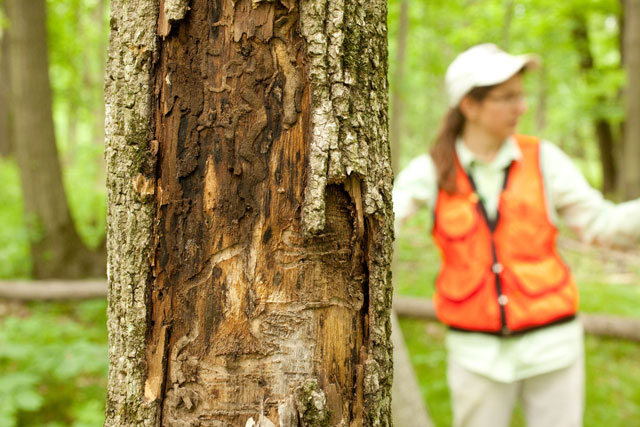 Dead green ash tree showing bark splitting and serpentine galleries. June 16, 2009. Southeastern MI. One of the early
symptoms of EAB infection
is the occurence of "epicormic branching," i.e.,
broom-like clusters of branches emanating from the
trunk.
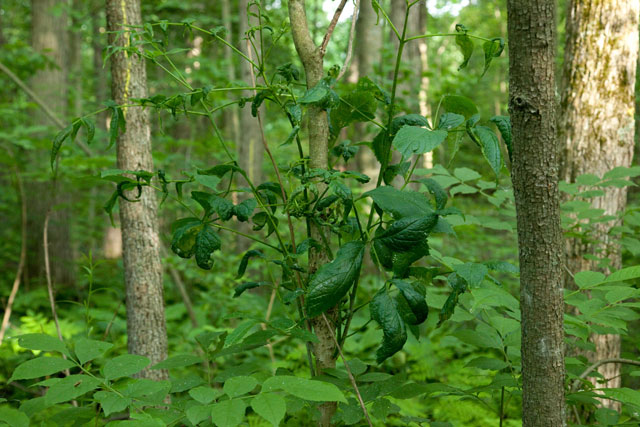 Moribund ash tree in southeastern Michigan swamp. June 16, 2009. Early attempts to halt
or slow the spread
of the beetle included sanitation cutting of ash trees. Here are some
trees felled for that purpose.
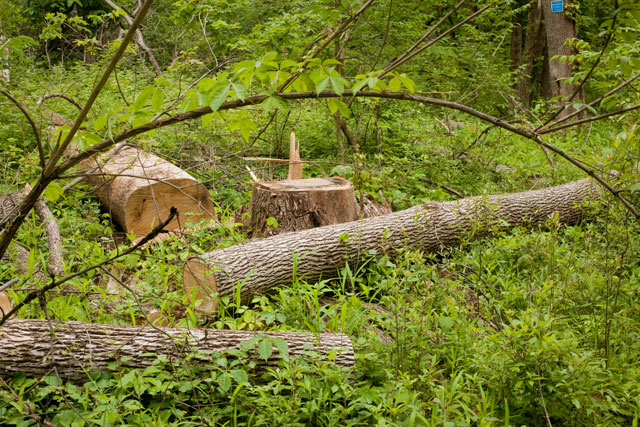 Ash trees felled to slow EAB. Photo taken June 16, 2009. Southeastern MI. Examination of some
felled logs shows extensive galleries and characteristic
D-shaped emergence holes.
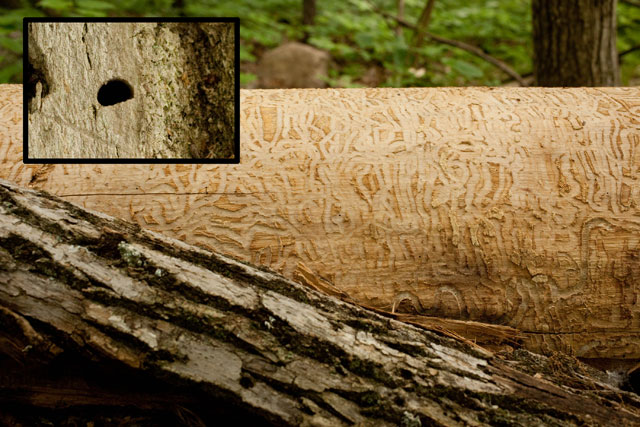 Ash log showing extensive larval galleries. June 16, 2009. Southeastern MI. Inset: characteristic D-shaped emergence hole through the outer bark. At an upland site, the
EAB effects are
less devastating, but only because there were fewer ash trees there to
begin with. Nevertheless, the other trees are getting very nervous.
This beech tree is avoiding predation through
cryptic coloration,
concealing its appearance by effecting a resemblance to a moth.
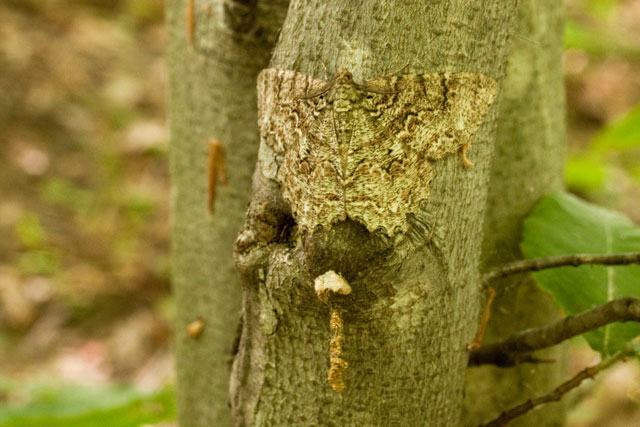 Beech tree hiding
beneath a moth in southeastern Michigan. June 16, 2009.
[Note from Dave Horn: the moth is Epimecis hortaria (Geometridae), the "Tulip-tree Beauty." It's fairly common in areas where the host plants occur (Tulip Tree, Poplar, Sassafras or Pawpaw, which is an eclectic mix). The larva is one of the largest inchworms we have -- easily a 2-incher.] ...and on the forest
floor, is basswood
rapidly evolving defensive limbs, complete with digits? No. This is a
dramatic demonstration of cotyledons,
also called "seed leaves," structures that provide nutrition to the
young sprout before its true leaves expand and take
up the
job of photosynthesis. Cotyledons are the main source of nourishment
for many seeds. (Some other seeds, such as grains, use a tissue called
endosperm. Popcorn is mostly puffed endosperm! Try asking for that
at the local cineplex.) Cotyledons are what eager gardeners first
notice when their bean, carrot, sunflower,
etc., seeds sprout, and they are typically paired, indicative of
membership in the great sub-group of flowering plants accordingly
termed
"dicotyledons" ("dicots" for short). Cotyledons are oppositely
arranged even if the normal true leaves are alternate, and they are
differently shaped than the true leaves. Most cotyledons are dully
ovoid, less intricate than the true leaves that follow, but with
basswood it's the other way around. Basswood's deeply palmate
cotyledons are
wild, whereas the true leaves are hum-drum.
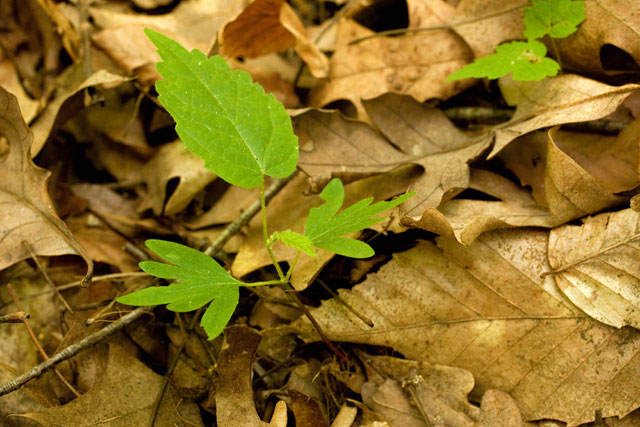 Basswood seedling showing distinctive palmately lobed cotyledons. June 16, 2009. One of the concerns
about EAB is that the
gaps it creates will provide a conduit for more effective invasion by
weedy alien plants such as garlic mustard, privet, and various Asian
honeysuckles that are already disrupting ecosystems in eastern
North America. Also, the loss of an entire genus of trees is
a
great blow to biodiversity. Chestnut blight, which eliminated the
American chestnut at the turn of the last century, was probably felt as
a greater loss because chestnut was more dominant in
its forests
than ash is today, most often occurring admixed with
other
species. (Also chestnuts were important wildlife food, and the lumber
was prized.)
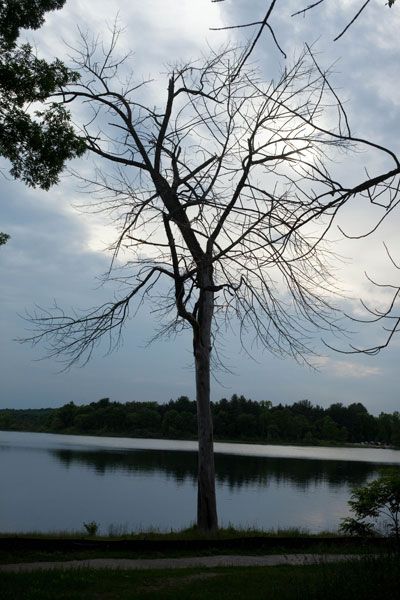 Ash tree victim of EAB. June 16, 2009. SE MI. This is not to understate the significance of the harm caused by EAB. If, say, all the ash trees die and their neighboring hickories, oaks, basswood, etc. take up a little more space than they otherwise would have, this is a step --a pretty big step! --down a slope of progressive deterioration of our ecosystem. Sadly, it might not be noticed for very long, not because it's not important, but because of a recently acknowledged perceptual phenomenon known as "shifting baselines." This term, originally coined by marine biologist Daniel Pauly and more recently promoted by biologist/filmaker ("Flock of Dodos")/blogger Randy Olson, is a type of "generational and personal amnesia" wherein peoples' perceptions of what is pristine is based on their recent experiences or what they have been told is natural. Randy, in an excellent podcast that can be listened to here (Skepticality #064, 10/30/2007), relates a telling anecdote about when he took his college students to a coral reef he that was familiar with from early in his career when the coral were all healthy and the reef was teeming with fish and other marine life. The reef he took his students to see was nearly all gone, but after seeing some coral and some fish, the young people breathlessy raved about how it was the most beautiful lush rich place they had ever been to, and aren't coral reefs great?! Randy Olson explains that if we don't retain an accurate picture of reference points from the past, it's going to be hard to work towards conserving anything. If properly publicized, the work of these USDA Forest Service and OSU researchers will go a long way towards the preservation of what remains. 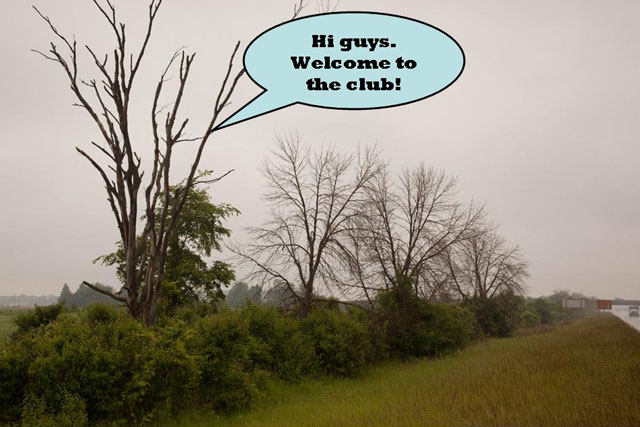 Roadside elm and ash trees, both victims of introduced pests. June 17, 2009. Southeastern Michigan. Marion-Wyandot County Line Rd. June 14, 2009 Unlike most of our
other milkweeds (genus Asclepias in family
Asclepiadaceae) which are plants of sunny areas, poke milkweed (A.
exaltata) occurs in rich woods and along their edges. It
bears umbels of white flowers on long flexuous pedicels.
Iris is expecting!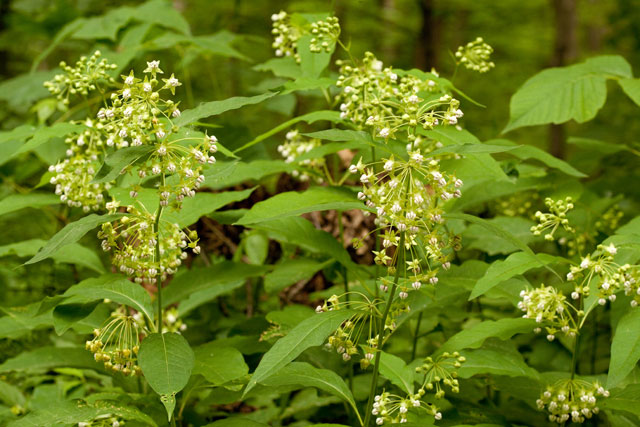 Poke milkweed along woodland edge. Wyandot County, Ohio. June 14, 2009. Milkweed flowers are
peculiar. The 5
petals are swept back sharply. Set atop them is a "corona," consisting
of 5 cups of nectar termed "hoods," from each of which
projects a
pointed elongate "horn." After that it gets pretty complicated. (Further
details of milkweed floral biology were observed and described last
July.)
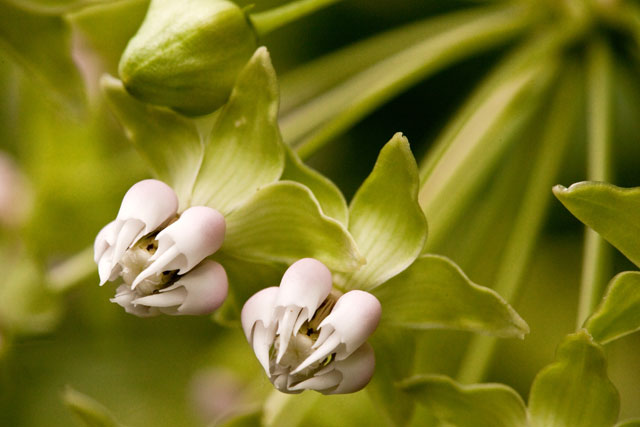 Poke milkweed flowers. June 14, 2009. Wyandot County, Ohio. Two inconspicuous and
seemingly anomalous
members of the Apiaceae (parsely family) are especially
abundant
in the woods this time of year. These are honewort (Cryptotaenia
canadensis) and sanicle (Sanicula gregaria).
What makes them inconspicuous is the small size of their flowers.
The seeming anomaly is that the infloresence is not an
the umbrella-like umbel we expect on members of the Queen
Anne's
lace, poison hemlock, and dillweed family.
The tiny white flowers of honewort are in loose umbels with variable-length flower stalks, giving it a more ragged appearance than other members of the Apiaceae. 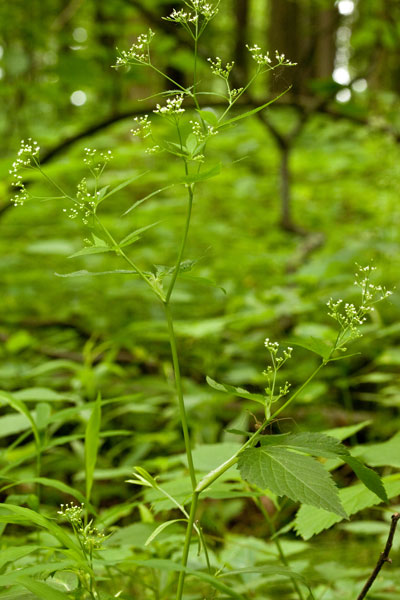 Honewort at Myers Woods. June 14, 2009. The tiny greenish-yellow flowers of sanicle are in small head-like umbels. 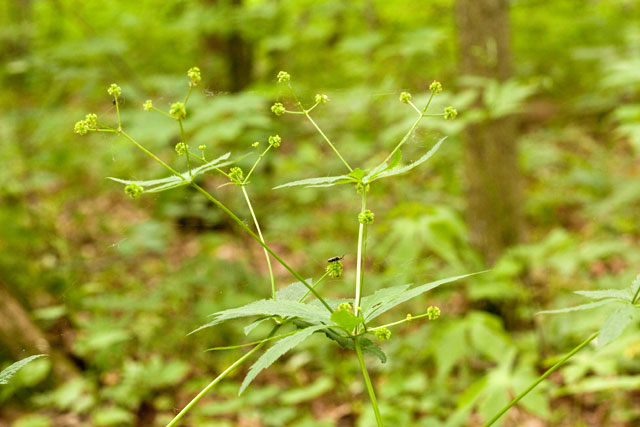 Sanicle at Myers Woods Preserve, Marion County, Ohio. June 14, 2009. Bedstraws apparently
have an anger
management problem because they're in the Rubiaceae, the madder family.
I don't know why its called the madder family. There must be a plant
named "madder." Coffee is also in the Rubiaceae. It should be called
the perkier family. Anyhow, scattered moist spots and the roadside
ditch here are occupied by shining bedstraw, Galium concinnum.
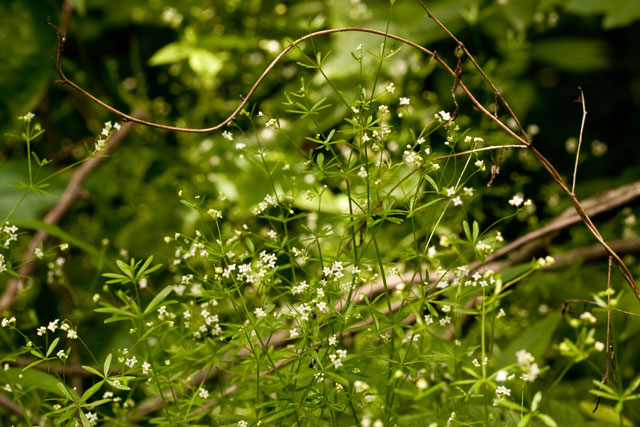 Shining bedstraw alongside the Marion/Wyandot line. June 14, 2009. Bedstraws have whorled leaves and small flowers with (in most species) 4 fused petals and a deeply 2-lobed inferior ovary. 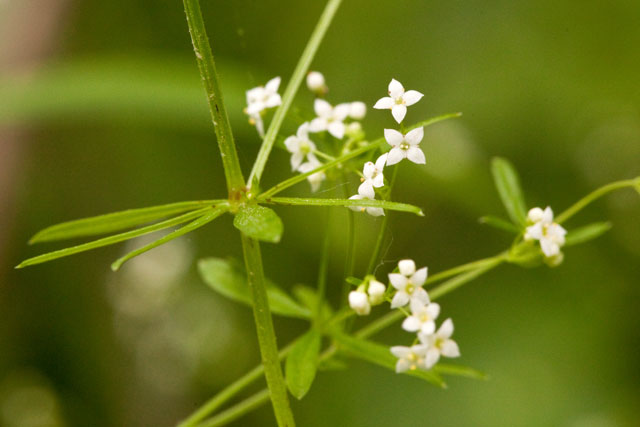 Shining bedstraw. June 14, 2009. Wyandot County, Ohio. One of our more
striking sedges, the squarrose sedge, Carex squarrosa,
is seen alongside the bedstraw. It produces its wind-pollinated flowers
in spiral clusters called "spikelets," two of which are shown
here.
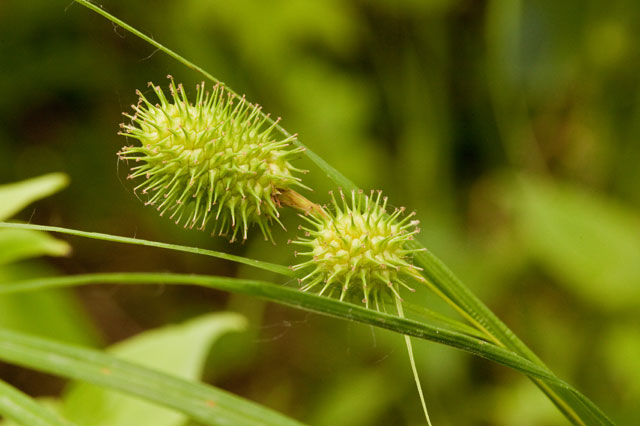 Squarrose sedge. Wyandot County, Ohio. June 14, 2009. Friendly mutants
endowed with hyper-functional red-green color vision tell me that
fire-pink (Silene virginica,
family Caryophyllaceae) is a conspicuous wildflower. It is one of a
small handful of truly red native Ohio flowers, including two
other Silene species: round-leaved catchfly (S. rotundifolia)
and royal catchfly (S. regia) as well as
cardinal-flower (Lobelia cardinalis, family
Campanulaceae).
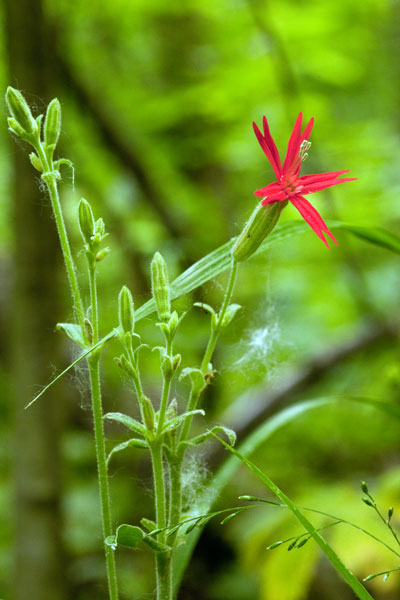 Fire-pink at Myer's Woods. Marion County. Ohio. June 14, 2009. Meanwhile, wild
geranium is apparently
tossing seeds around. The species exhibits ballistic seed dispersal as
the 5-chambered fruit with one seed in each chamber) splits upwards
with great velocity and springiness. I've never seen this in action. It
would be fun to see.
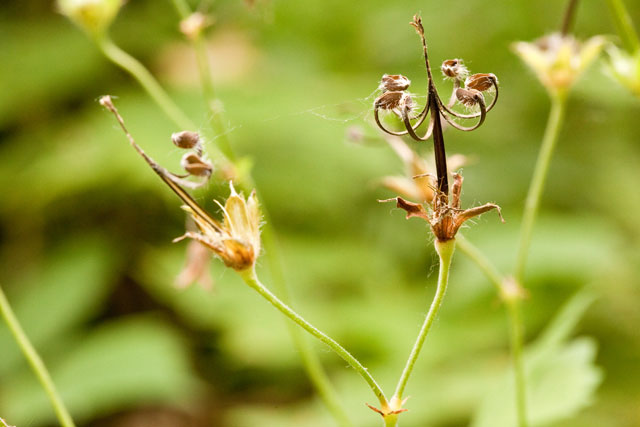 Wild geranium fruits. June 14, 2009. Marion County, Ohio. June 14, 2009. Marion, Ohio. Iris flowers observed last month
were seen to have an inferior ovary. Now the plants are mostly done
blooming, and it is evident that pollination was successful and babies
are in the way!
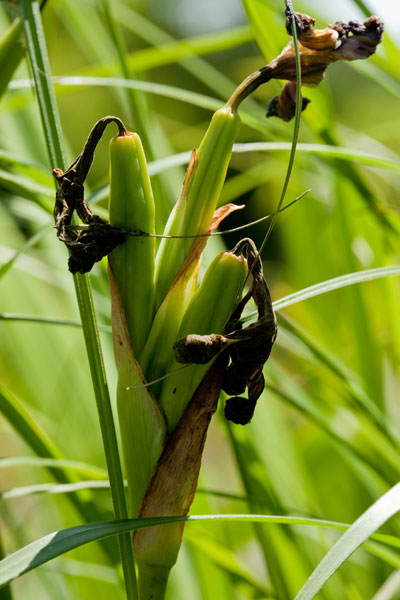 Young iris fruits. June 14, 2009. Marion Ohio. One cute fruit, two mingled mosses and beard-tongue revealed along the Scioto River, Columbus, Ohio, June 11, 2009 A couple of months ago
it was a pleasure to see twin-leaf
flowering in
the calcareous soil of a wooded bank overlooking the Scioto River in
Columbus. Since then the fruits have matured and shed their
seeds. The twinleaf fruit is a solitary capsule set atop a wiry stalk,
positioned just above the deeply 2-cleft twinleaf leaf. It looks like
Kermit the unicorn.
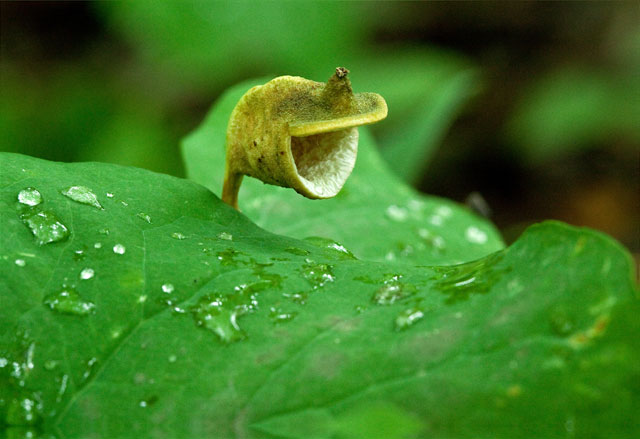 Twinleaf fruit at the park with the hard to spell French name. June 11, 2009. Meanwhile, since it just just rained, two saxicolous (i.e., growing on rock) mosses are especially lush. The more robust one in the upper half of the photo is Hedwigia ciliata, while in the "understory," bearing numerous sporophytes, is Homomalium adnatum. 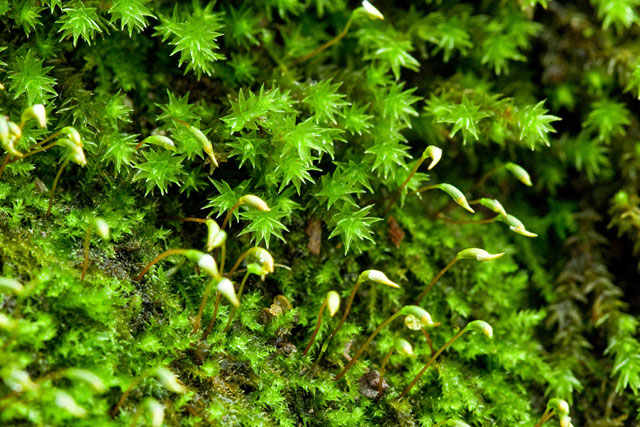 Hedwigia is
remarkable for its
strikingly different appearance depending upon whether it is wet or
dry. It looks like a totally different plant! Here it is dry (also
bearing sporophytes). The leaves have distinctive whitish-gray tips.
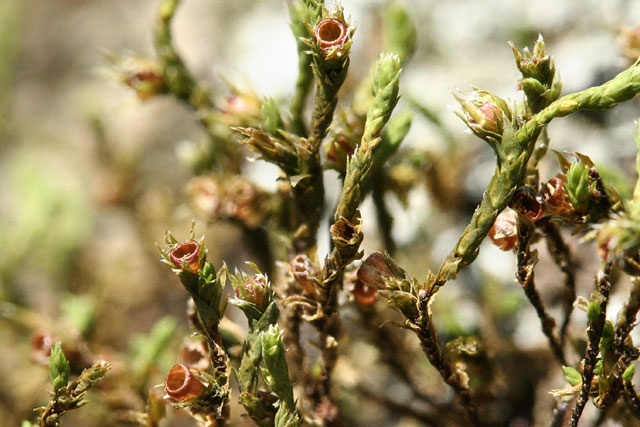 Hedwigia ciliata in wooded sanctuary, Delaware County, Ohio. April 27, 2007. On the west side of the
river near the
Fissinger Road bridge, limestone bluffs line the shore. A
suite of
typical rocky-site plants grows there including hop-tree, fragrant
sumac, chinkapin oak and, currently nearing the end of its bloming
period, this hairy beard-tongue (Pentsemon hirsutus,
family Scrophulariaceae).
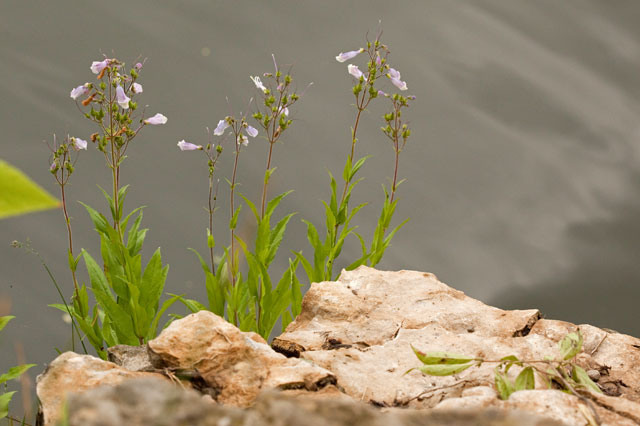 Hairy beard-tongue along west bank of Scioto River, Columbus Ohio. June 11, 2009. The beard-tongues are
perennial herbs with
a tubular corolla consisting of 5 fused petals, and exhibiting a
bilateral symmetry that is also "bilabiate" (2-lipped). Two petal-lobes
make up the top lip, and three lobes the lower lip. The fruit
is a
many-seeded capsule. In the photo below, young capsules are evident,
with the elongate style still attached.
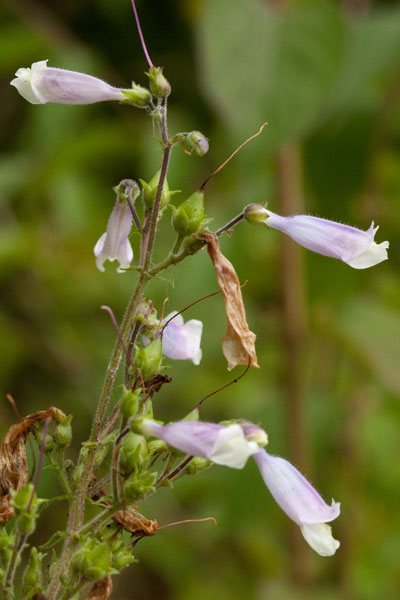 Hairy beard-tongue. June 11, 2009. On the banks of the sci-oh-to. The
distinctive construction of the beard-tongue flower is the basis of
both its common name scientific names. Penstemon is
from the Greek (why do they say "the Greek," instead of just "Greek"?) pente,
five, and stemon,
thread, in reference to the presence of a 5th stamen that is sterile,
and very different from the four fertile stamens. The sterile 5th
stamen is especially long, and has a tuft of hairs at the end. The
function of the hairs is to tickle the bee's belly, causing it to laugh
uproariously, thereby picking up more pollen from the fertile stamens
than would a gloomy old sour-puss bee. One of the flowers was
neatly
dissected, not by me for a change; it apparently happened naturally.
(Carpenter bee
is the likely culprit.)
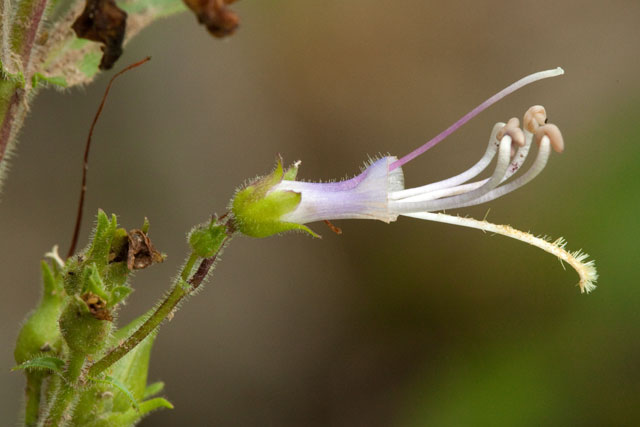 Beard-tongue flower dissected, showing elongate style (top), 4 anther bearing (fertile) stamens, and a sterile, bearded, 5th stamen. June 11, 2009. Columbus, Ohio. Several cool-season grasses flowering Larry R. Yoder Prairie at OSU-Marion June 10, 2009, Marion, Ohio Grasses (family
Poaceae) flowers are minute. It's fun to
look at them closeup, and see how well adapted they are for
wind-pollination. Note the drooping stamens consisting of
a relatively large pollen-producing anther at the end of a very slender
filament. Look also for the feathery pollen-receptive stigmas. (These
are often harder to discern.)
Grasses are sometimes grouped according to seasonality of growth and reproduction. "Cool-season grasses" (obviously) thrive during spring and early summer, and go dormant in the dry hot middle of summer. Many weedy grasses are cool-season ones, including the following that were seen today at the prairie: orchard-grass (Dactylis glomerata), reed-canary grass (Phalaris arundinacea), quack-grass (Elytrigia repens), Hungarian brome (Bromus inermis), and tall fescue (Festuca eliator). But don't worry --the lovely native prairie dominant "warm-season grasses" are starting to get lush, and we'll see them flourishing in a month or two. Orchard grass is a European native, found in moist fields, lawns, and meadows throughout al-l North America except arctic and desert regions. 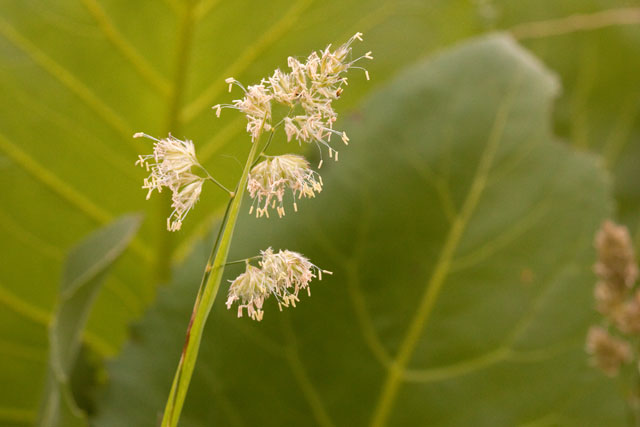 Orchard grass with
prairie dock leaves in background.
Larry R. Yoder Prairie at OSU-Marion. June 10, 2009. Orchard grass flower
clusters (spikelets) are arranged in several dense one-sided clusters
at the ends of branches.
Orchard grass with prairie dock leaves in background.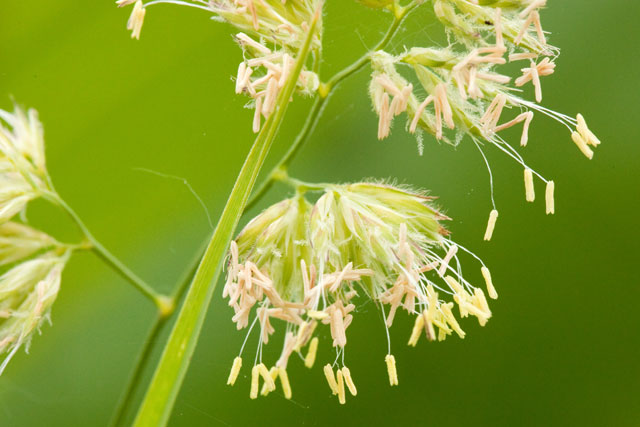 Larry R. Yoder Prairie at OSU-Marion. June 10, 2009 Unlike most other invasive plants, reed canary grass is a native species. It occurs in streambanks and moist ground. Spreading rapidly from rhizomes, reed canary grass is an aggressive prairie weed. 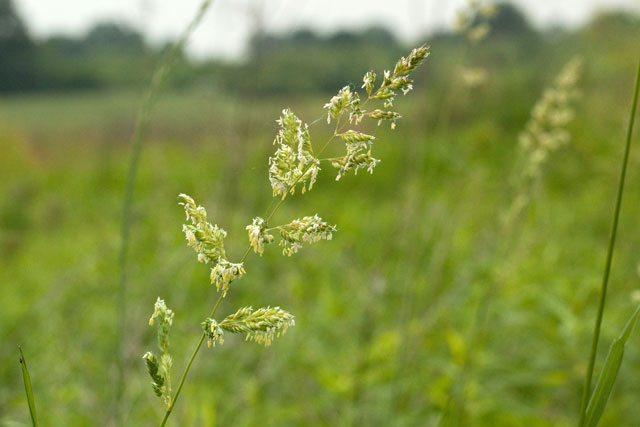 Reed canary grass. Larry R. Yoder Prairie at OSU-Marion. June 10, 2009 Reed canary grass, when is is flowering, has an overall aspect similar to orchard grass, with several clusters of spikelets held at a a divergent angle off the main stem. Later on, however, the reed canary grass inflorescence contracts, looking more wand-like. 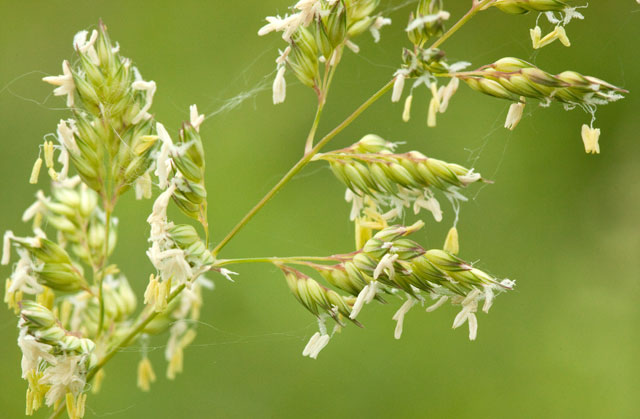 Reed canary grass flowers. Larry R. Yoder Prairie at OSU-Marion. June 10, 2009 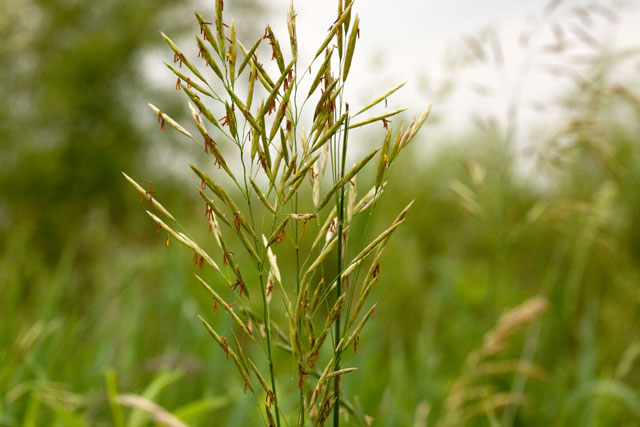 Hungarian
brome flowers. Larry R. Yoder Prairie
at OSU-Marion. June 10, 2009
Hungarian brome illustrates well the typical grass inflorescence type called a "spikelet." Each spikelet is a row of several flowers each of which is tucked between a pair of scale-like bracts (lemma and palea), with the whole row subtended by a sterile pair of bracts (glumes) at its base. 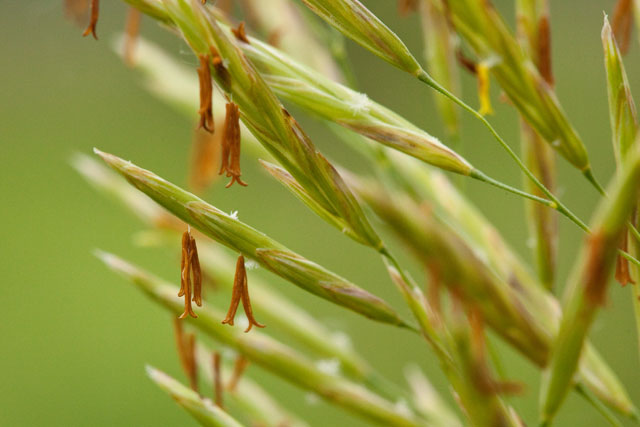 Hungarian
brome spikelets. Larry R. Yoder Prairie at
OSU-Marion. June 10, 2009
Quack grass is European weed widely distributed across the nothern U.S. and adjacent Canada. 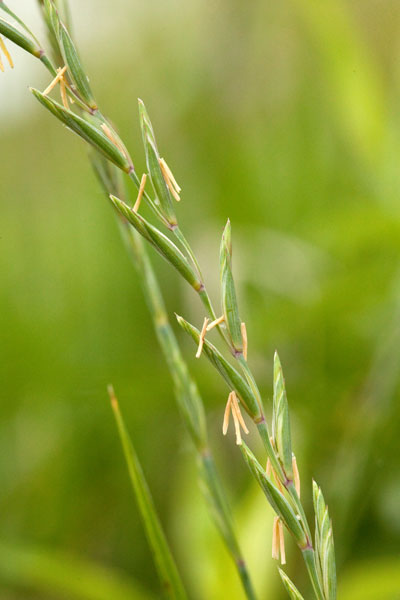 Quack grass. June 10, 2009. Larry R. Yoder Prairie at OSU-Marion. June 10, 2009 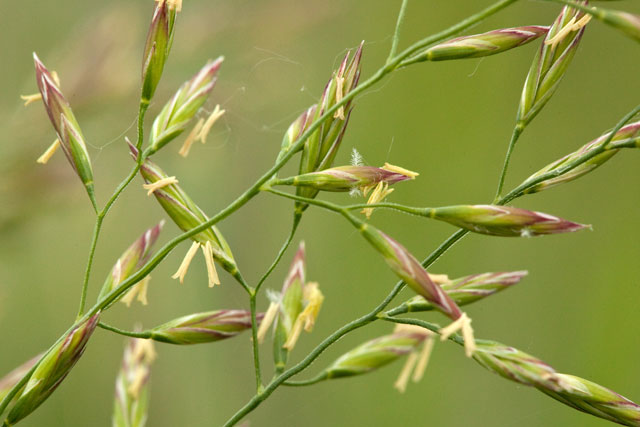 Tall fescue at Larry R. Yoder Prairie at OSU-Marion. June 10, 2009 Larry R. Yoder Prairie at OSU-Marion June 10, 2009, Marion, Ohio Northern sundrops (Oenothera tetragona, family Onagraceae) is an evening-primrose working the day shift. (It blooms in the daytime and is pollinated by long-tongued bees and butterflies, not night-flying moths as are many other members of the genus.) The Oenothera flower is distinctive in many respects. Numerologically reminiscent of, but not closely related to, mustards (family Brassicaceae), members of the evening-primrose family have 4-merous flowers: 4 sepals, 4 separate petals, 8 stamens, and a single pistil consisting of 4 fused seed-bearing units (carpels). The sundrops pistil is topped by a widely 4-branched stigma, hence the flower looks like a star-nosed mole! 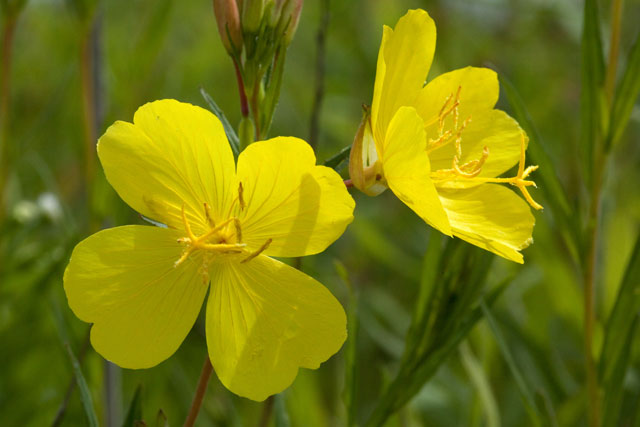 Sundrops at Larry R. Yoder Prairie. June 10, 2009, Marion, Ohio. The sundrops ovary is
inferior and the
flower's attachment to the stem is sessile (stalkess), but it doesn't
look that way at first glance because the flower has a hypanthium
(floral
tube) that is so long and slender that it could be mistaken for a
flower stalk! In the photo below, the ovary is the swollen ridged
structure attached to the stem.
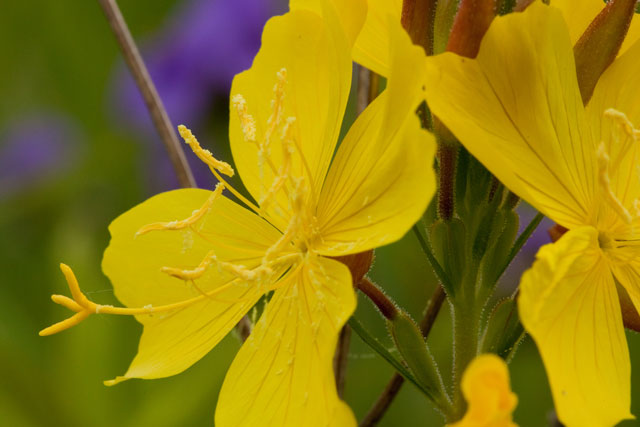 Sundrops showing
ovary at Larry R. Yoder Prairie. June 10, 2009, Marion, Ohio.
There are persistent
stems of last-year's fruiting spikes with leftover empty old capsules.
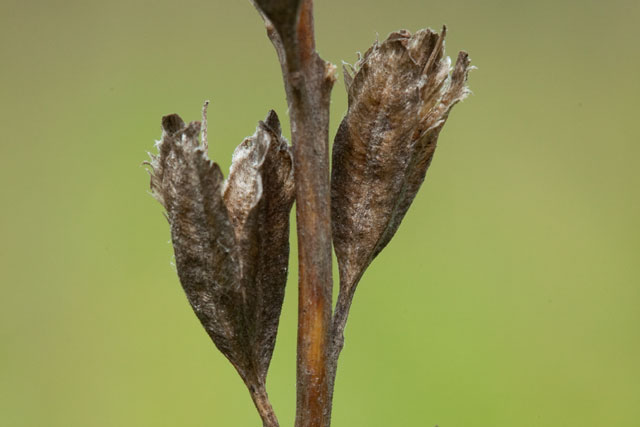 Persistent old sundrops fruits. June 4, 2009. Marion, Ohio. Among the sundrops and
scattered elsewhere throughout the prairie, Ohio spiderwort (Tradescantia
ohioense,
family Commelinaceae) advertises its presence. These flowers are
historically and educationally important. The filament (slender
supporting stalk) portion of
the spiderwort stamen is very hairy. These hairs are
well
known for being one of the best subjects with which biology students
can observe
microscopically the phenomenon known as "cytoplasmic streaming,"
wherein cellular organelles move along a regular path,
pulled by protein strands too small to see. Also, the
all-important cell nucleus was first observed in a spiderwort stamen,
by Robert Brown in 1831.
The internet is way over-rated!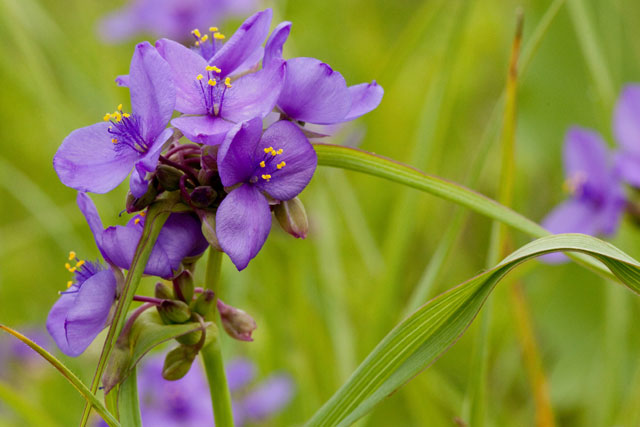 Ohio spiderwort at the Larry R. Yoder Prairie at OSU-Marion. June 10, 2009. While most of the
spiderwort blooms are
deep blue as seen above, a few are much paler, approaching pink or
light lavender or somethingn like that.
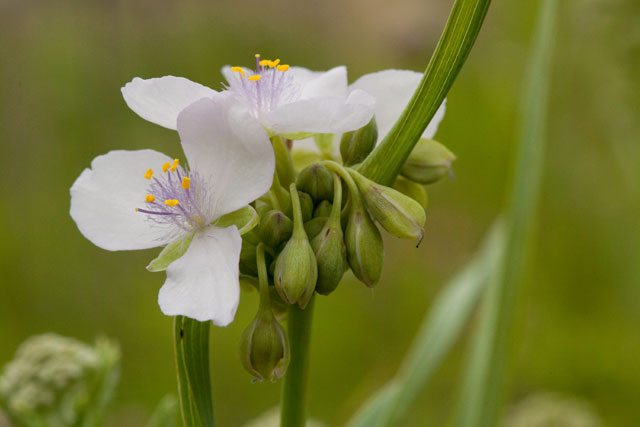 Pale spiderwort flower at Larry R. Yoder Prairie. Marion Ohio. June 10, 2009. The buttercup family
(Ranunculaceae) in made up mainly of early spring-blooming
flowers, so it is nice to see
a couple of them now. Below is Canada anenome --a
perennial herb that bears a pair of large sessile 5-lobed
oppositely arranged leaves, above which extends a
single white flower possessing 5 showy petal-like sepals.
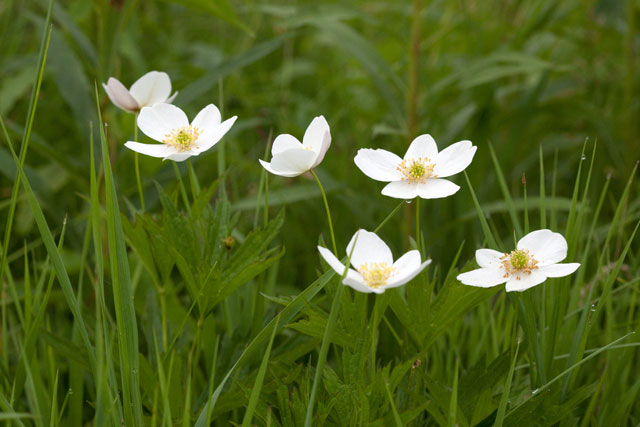 Canada anemone at Larry R. Yoder Prairie at OSU-Marion. June 10, 2009. Canada anemone displays
well the entire
suite of buttercup flower traits. The flower is radially symmetric, and
the parts are separate from one another. The stamens and carpels are
also separate (this is an "apocarpous gynoecium"), numerous
and spirally arranged. In the
flower
below, note the slender stamens attached below, and spreading
peripherally around, the centrally located carpels.
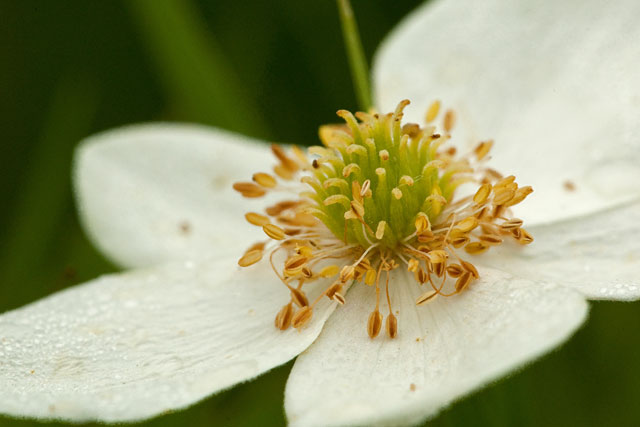 Canada anemone flower. Larry R. Yoder Prairie at OSU-Marion. June 10, 2009. Nearby, two
opposite-sexed individuals of a dioecious
member of the buttercup family are found, standing
romantically close to one another. Below, meet Ms. Meadow-rue
(pistillate Thalictrum dasycarpum).
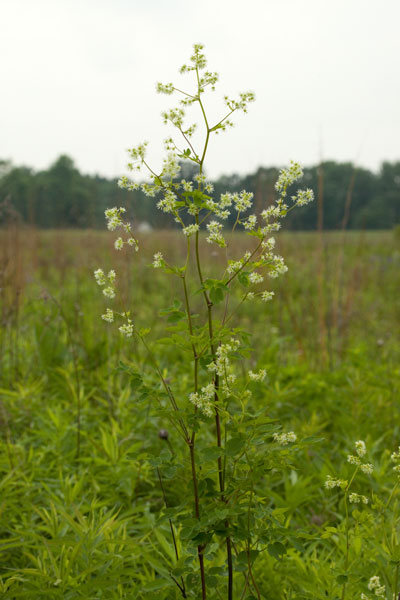 Pistillate meadow-rue. June 10, 2009. The species is
wind-pollinated. Each
pistillate flower (4 are shown below) consists of roughly one dozen
separate carpels, each adorned with an especially long and prominent
pollen-receptive stigma. The flowers of the male individuals (approx.
12 flowers are shown below) consist mainly of a neat tuft
of stamens that dangle in the breeze, casting pollen grains
aloft.
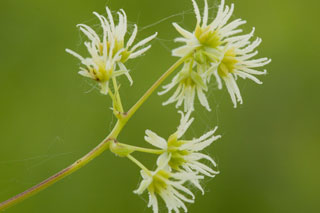 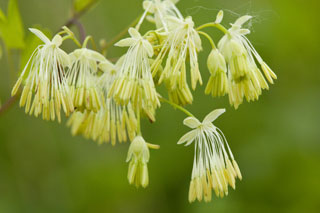 Tall meadow-rue flowers. Left: pistillate. Right: staminate. Delaware
County, Ohio
June 7,
2009
Back in March, skunk
cabbage (Symplocarpus foetidus, family Araceae) was
in bloom along a wooded tributary to Alum Creek. Details of its
flower
structure were demonstrated. Today my wife and I revisited
the site. The
leaves are huge.
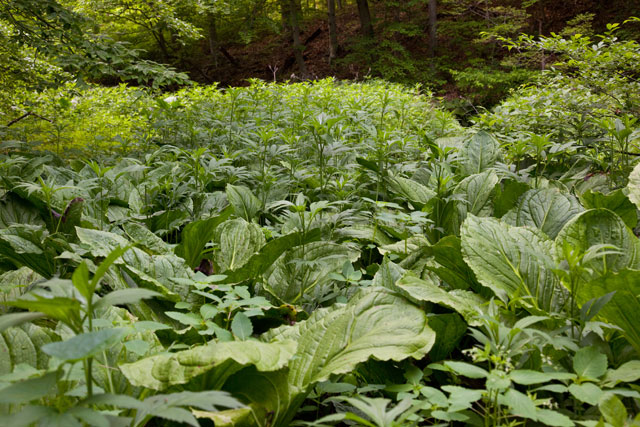 Skunk cabbage is dominant along tributary to Alum Creek. Delaware County, Ohio. June 13, 2009. Skunk cabbage is an
"arum," i.e., a member of the plant family Araceae, characterized by
having small flowers closely aggregated over a fleshy spike (the
"spadix"), usually subtended by a large leaf-like bract (the
"spathe"). Here is an individual skunk cabbage plant. Note the fruiting
structure at its base.
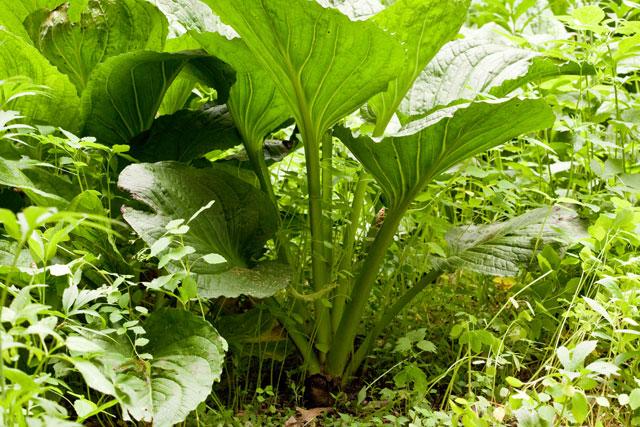 Skunk cabbage plant in fruit. June 6, 2009. Delaware County, Ohio. O.K., the fruiting
structure is difficult to see from so far away, so
here is a closer view.
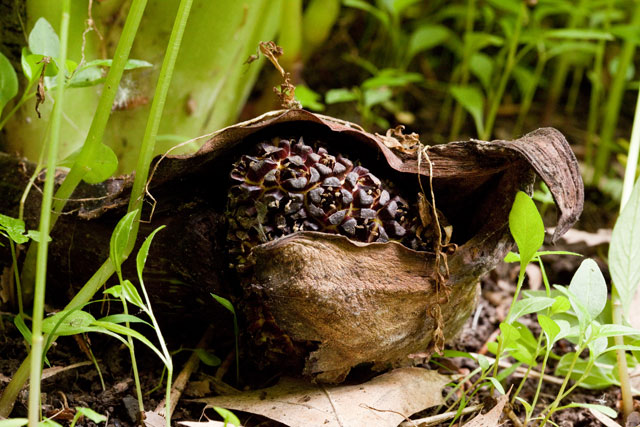 Skunk cabbage spadix and spathe. June 6, 2009. Delaware County, Ohio. The individual skunk
cabbage flowers are persistent even though pollination took place three
months ago. Below is a closer view of the spadix, sliced tangentially
a few millimeters deep to better delineate the flower parts. Note
intact unsliced flowers at the periphery of the sliced
region. The flowers each have 4 conspicuous hood-shaped petals (better
termed "perianth segments" since sepals are absent and also that's what
the
book calls them). Stamens sit opposite the perianth segments, between
them and the single, central, pistil.
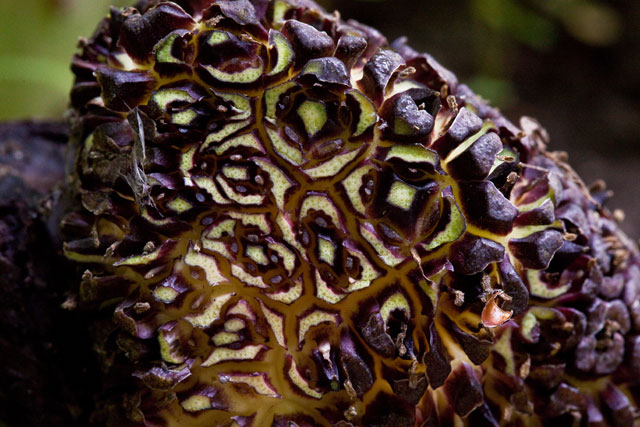 Skunk cabbage spathe shallowly sectioned to reveal flower parts. The following is an
enlarged view of a portion of the picture above, with parts labelled.
MOUSEOVER the
IMAGE to
see flower details
Skunk cabbage spathe
sectioned slightly. June 6, 2009. Delaware County, Ohio.
The skunk cabbage ovary is buried in the tissues of the spadix. It contains one chamber within which there is one ovule, eventually developing into a fairly huge --1 cm. -- seed embedded in the spongy tissues of the spadix, covered by the persistent perianth and style. Here is a cross-section of a spadix, exposing a couple of seeds (each within a thin-walled fruit). 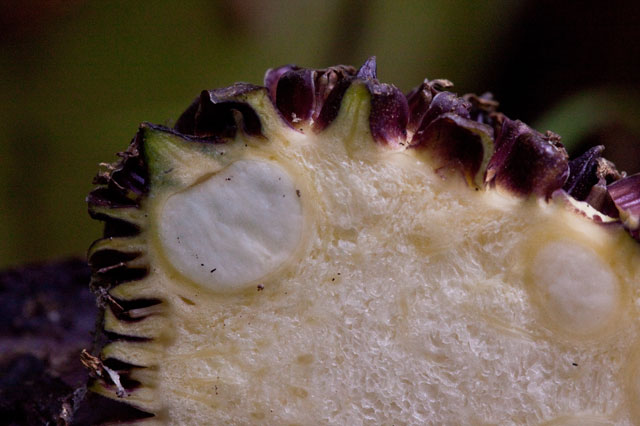 Skunk cabbage fruit, sectioned, showing two seeds. June 6, 2009. Delaware County, Ohio. It appears that the
proportion of flowers
that actually set fruit
is quite low. What determines that? Are they pollen-limited? Or perhaps
fruit-set is generally low irrespective of the level of pollination.
Many plants often produce way more flowers than fruit, for a variety of
reasons. These include: unpredictable resources that might
occassionally be abundant; pollinator attraction, and; male function
(as a flower that does not set fruit may nonetheless donate pollen to
sire seeds on other plants in the population).
(Books are better, if you can find them.) This really galls me --June 1, 2009, Columbus Ohio Merrily walking down
the street we bumped
into a friendly talkative neighbor gardening in her front yard.
Fortunately for the botanical introverted among us who become "all
talked out" around sentence three, we were standing beneath a lovely
white oak (Quercus alba, family Fagaceae) that
happened to have
an intriguing gall on several of its leafstalks. This was quite a
conversation piece, and the neighbor said "You have a lot of
gall!" Really.
Intriguing galls on black oak. May 21, 2006. Scioto
County, Ohio. 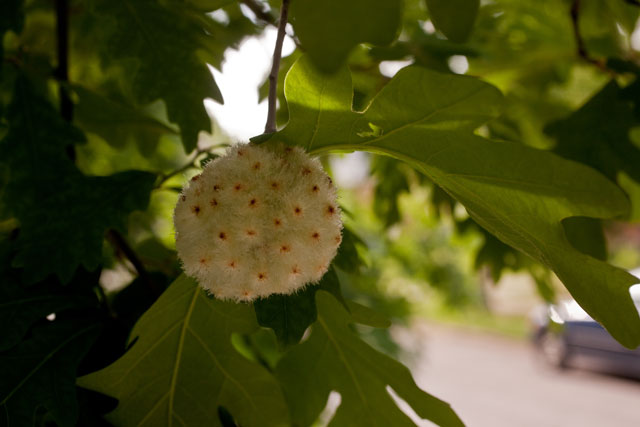 Intriguing gall on white oak. June 1, 2009. Columbus Ohio. Galls are peculiar
growths produced by
plants in response to injury by some other organism. They tend to be
very distinctive, and specific for the agent that causes them. Galls
occur on a great many plants, typically invoked
by fungi, mites, or insects. Mostly they serve to
complete
the reproductive phase of the life cycle of the gall-inducing organism.
If its an insect gall, for instance, slicing open the gall might reveal
a larva or pupa. It's amazing that the galls are so structually
intricate and effective in rearing what are essentially the plant's
enemies. Why do the plants provide such a nice home for them? Maybe
it's gangland extortion-like coevolution. The insect (or
whatever)
could potentially harm vital parts of the plant. So the plant "defends"
itself by providing what the bug needs in an accessory structure that
is not very costly to produce and doesn't disrupt vital
processes such as
flowering, photosynthesis, or vascular transport. An analogy: If you
knew that some creepy burglar was going to smash open your house and
take some money, maybe you'd choose instead to simply leave a
few
bills in an envelope taped to the door. Is a plant gall like the
money-filled
envelope, presented to circumvent a more destructive interaction?
Oaks have more galls than any other tree. Many of the oak galls are caused by small wasps in the family Cynipidae (in the order Hymenoptera). The galls alone can be identified (and then you know the critter that caused it). Somewhere I have two terrific old books about galls that could have ID'd the mystery gall above, but they are A.W.O.L. It ought to be simple enough to "search the web" to find out what this gall is, but that proved fruitless. There's a lot of general introductory info about galls and pictures of a few especially common ones, but specialized and detailed gall material seems to be lacking in cyberspace. The following are several additional intriguing oak galls seen during the past few years, each on a different species of oak. First, this solid woody one is on shingle oak (Quercus imbricaria). It is said to contain a high concentration of tannic acid, and is somehow used to make ink. 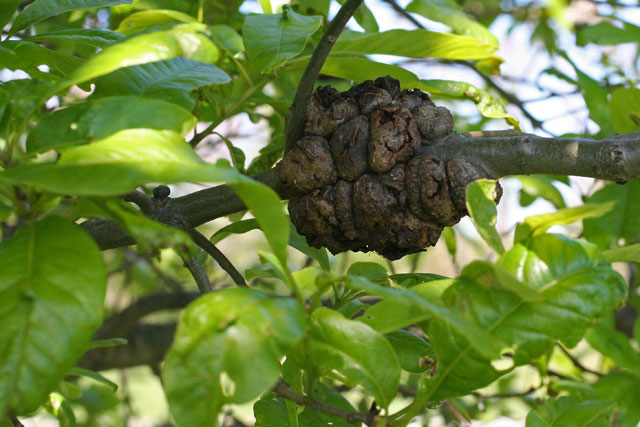 Intriguing gall on shingle oak. May 26, 2006. Marion, Ohio. These
ping-pong-ball-like ones are on black oak (Quercus velutina).
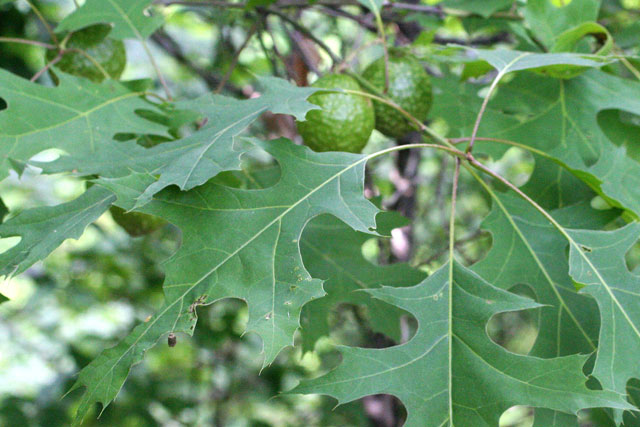 These little buttons are on the undersurface of a chinkapin oak (Quercus muehlenbergii) leaf. 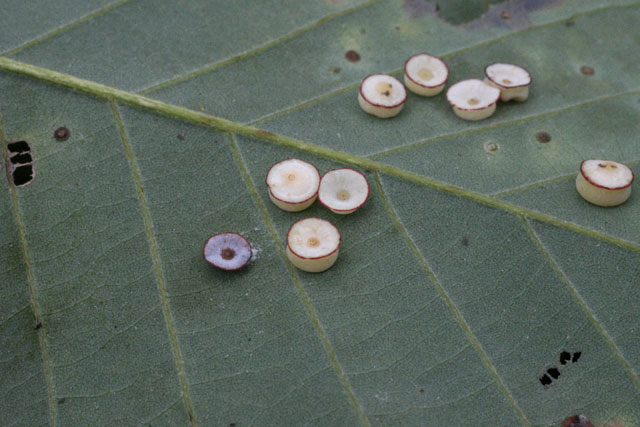 Intriguing galls on chinkapin oak. August 29, 2006. Pickaway County, Ohio This grape-like cluster
is on the midvein of of a bur oak (Quercus macrocarpa)
leaf.
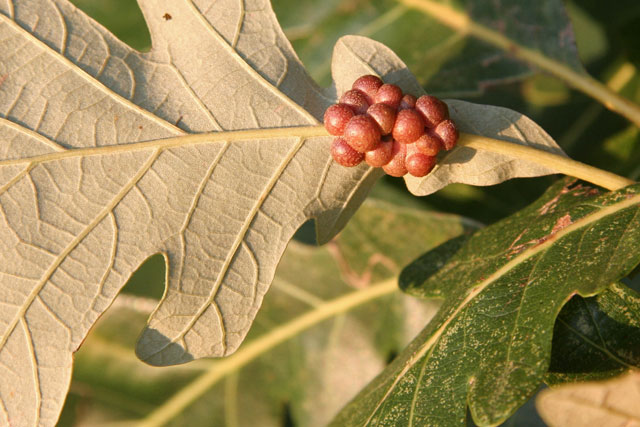 Newer observations ("next") |
